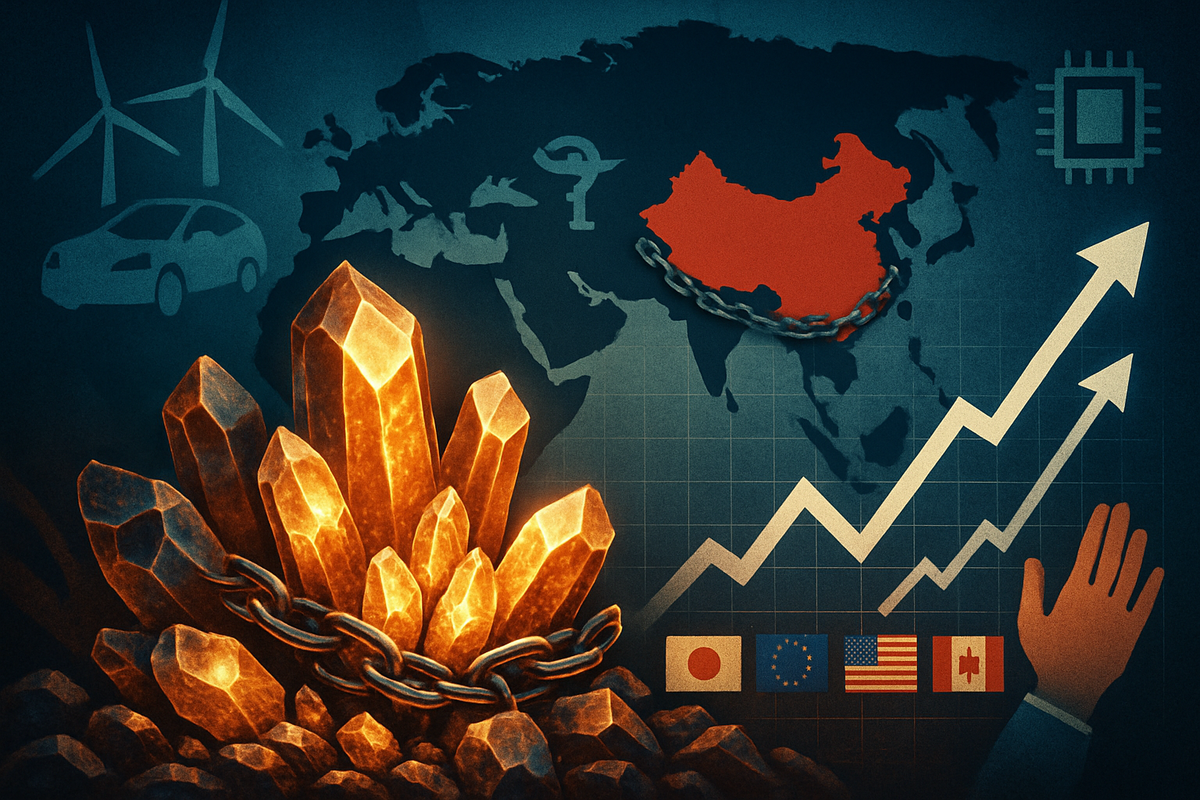Financial News
China's Rare Earth Export Clampdown Ignites Global Mining Stocks, Reshaping Materials Sector Dynamics

October 9, 2025 - The global materials sector is experiencing a significant upheaval today, as China's escalating restrictions on rare earth exports send ripples across international supply chains and ignite a notable surge in the shares of non-Chinese mining companies. These strategic moves by Beijing, culminating in expanded controls announced this month, are compelling nations worldwide to accelerate efforts in diversifying their critical mineral sources, creating a unique opportunity for alternative suppliers outside of China.
The immediate implications are clear: increased volatility in rare earth prices, heightened demand for non-Chinese rare earth production, and a bullish sentiment for companies poised to fill the looming supply gaps. This geopolitical chess match over essential industrial materials is not just reshaping trade policies but is also redefining the investment landscape for the mining industry.
Beijing's Iron Grip Tightens on Critical Minerals
China, which holds a dominant position in the global rare earth market, has systematically intensified its control over these vital materials throughout 2025. These actions are widely interpreted as strategic maneuvers to fortify national security, leverage trade negotiations, and solidify its pre-eminence in critical global supply chains. The timeline of these restrictions highlights a clear escalation.
The initial phase in April 2025 saw China impose export controls on seven specific rare earth elements—samarium, gadolinium, terbium, dysprosium, lutetium, scandium, and yttrium—and related products. This move necessitated export licenses, leading to immediate global supply anxieties. However, the most significant tightening arrived with the October 2025 expansion, which dramatically broadened the scope of these controls. The new regulations now encompass advanced processing technology for rare earth magnets, bar unauthorized overseas cooperation in rare earth projects, and explicitly limit exports to overseas defense and advanced semiconductor users (specifically 14nm chips or more advanced, memory chips with 256 layers or more). Five additional rare earth elements—holmium, erbium, thulium, europium, and ytterbium—were also added to the restricted list, bringing the total under tight control to twelve.
A particularly impactful measure is the "0.1% rule," which stipulates that if a product manufactured abroad contains Chinese-origin rare-earth materials exceeding 0.1% of its total value per independently usable unit, its onward export to a third country may also require approval from China's Ministry of Commerce (MOFCOM). These comprehensive measures also extend to intellectual property and extraction technologies, prohibiting Chinese citizens from unauthorized overseas mining activities. The staggered effective dates for these new regulations, some taking immediate effect, others on November 8, 2025, and December 1, 2025, underscore the phased yet resolute implementation by Beijing.
Initial market reactions have been swift and pronounced. Shares of key non-Chinese rare earth miners like MP Materials (NYSE: MP) surged over 6% following the October 9th announcement, reflecting investor confidence in its strategic value as a secure, domestic alternative. Other American rare earth miners, including Lithium Americas (NYSE: LAC) and Trilogy Metals (NYSE: TMQ), also experienced significant stock gains. Intriguingly, Chinese domestic rare earth companies also saw a substantial uplift, with China Northern Rare Earth Group, China Rare Earth Resources and Technology, and Shenghe Resources experiencing surges of 10%, 9.97%, and 9.4% respectively. This indicates that investors perceive these restrictions as strengthening the market position and pricing power of Chinese domestic producers, even as they create challenges for global consumers.
Companies Poised for Gains and Losses
The tightening of China's rare earth export controls is creating a clear bifurcation in the market, establishing a new landscape of potential winners and losers within the global materials sector. Companies with established rare earth operations outside of China are particularly well-positioned to benefit from the increased demand for diversified supply chains.
Leading the charge among the potential winners is MP Materials (NYSE: MP), which operates the Mountain Pass mine in the United States, North America's only integrated rare earth mining and processing facility of scale. The company's stock surge underscores its strategic importance as a vital domestic source, making it an attractive investment for those seeking to mitigate supply chain risks. Similarly, other American miners like Lithium Americas (NYSE: LAC) and Trilogy Metals (NYSE: TMQ), while not exclusively rare earth focused, are benefiting from the broader investor sentiment favoring secure, non-Chinese sources for critical minerals. These companies could see increased interest and investment as nations look to bolster their strategic mineral reserves.
On the Chinese front, domestic rare earth giants such as China Northern Rare Earth Group, China Rare Earth Resources and Technology, and Shenghe Resources are also experiencing significant gains. These companies are set to benefit from the enhanced pricing power and market control that China's export restrictions afford them within their own borders and in regulated international trade. However, companies heavily reliant on Chinese rare earth imports, particularly in the advanced manufacturing, defense, clean energy, and electronics sectors, face significant challenges. They will likely contend with higher material costs, increased supply chain complexity, and the imperative to rapidly reconfigure their procurement strategies, potentially impacting their profitability and production timelines.
Earlier in the year, before the latest tightening, some market volatility was observed for companies like USA Rare Earth, which saw a stock drop following increased Chinese rare earth mineral exports in July. This highlights the delicate balance and sensitivity of the rare earth market to perceived supply shifts, underscoring that while diversification is key, market dynamics remain complex and reactive to policy changes.
Wider Implications and Geopolitical Chessboard
China's aggressive posture on rare earth exports extends far beyond immediate market fluctuations; it represents a profound geopolitical realignment with significant implications for global industry, national security, and international relations. This event fits squarely into a broader trend of weaponizing economic dependencies, particularly in critical technologies and resources, as nations vie for technological supremacy and strategic autonomy.
The potential ripple effects are vast. Industries from electric vehicles (EVs) and wind turbines to advanced defense systems and consumer electronics are all heavily reliant on rare earths for their high-performance magnets and components. Manufacturers in these sectors, particularly those in the U.S. and Europe, will face considerable pressure to re-engineer products, find alternative materials, or establish entirely new supply chains. This could lead to higher production costs, slower innovation, and potential delays in the deployment of key technologies. Competitors in countries with nascent rare earth processing capabilities, or those investing heavily in recycling technologies, may see an accelerated path to market relevance. The European Commission has already expressed concerns and is actively studying the details of the new controls, signaling potential diplomatic and trade responses.
Historically, this situation echoes past instances where control over vital resources has been used as a geopolitical tool. Comparisons can be drawn to oil embargoes or restrictions on strategic metals during various historical periods, where the controlling nation sought to exert influence or gain leverage. The current situation, however, is unique due to the ubiquitous nature of rare earths in modern high-tech applications, making the stakes incredibly high for global technological development and economic stability. Regulatory and policy implications are paramount, as nations like the U.S. and EU are now compelled to fast-track legislation and funding for domestic mining, processing, and recycling initiatives to reduce their vulnerability to Chinese supply shocks. This could include subsidies, tax incentives, and streamlined permitting processes for rare earth projects.
The Road Ahead: Navigating a New Resource Landscape
The coming months and years will be crucial in determining the long-term impact of China's rare earth export restrictions. In the short term, industries reliant on these materials will face immediate supply constraints and escalating prices, forcing rapid strategic pivots. Companies will likely prioritize securing existing stockpiles, exploring alternative (though often less efficient) materials, and accelerating partnerships with non-Chinese rare earth producers. This period will be marked by intense supply chain re-evaluation and potentially volatile price movements for various rare earth elements.
Looking further ahead, the event is set to catalyze significant long-term shifts in global resource strategies. Nations are expected to double down on efforts to establish robust, independent rare earth supply chains, from mining and refining to manufacturing. This will open substantial market opportunities for companies involved in rare earth exploration, extraction, processing technologies, and advanced recycling methods outside of China. Investment in these areas is anticipated to surge, driven by both private capital and government initiatives aimed at national security and economic resilience. Potential strategic adaptations required include increased R&D into rare earth-free alternatives, greater emphasis on circular economy principles for critical minerals, and the development of new international trade agreements focused on secure resource access.
Potential scenarios range from a gradual global diversification of rare earth supplies, leading to a more balanced market, to a prolonged period of resource nationalism and heightened trade tensions. Should China's controls remain stringent, it could accelerate technological innovation in rare earth-free alternatives, potentially reducing the long-term strategic importance of these materials. Conversely, if alternative supplies prove insufficient or too costly, it could grant China even greater leverage. Investors should watch for continued government policy announcements, progress in new mining projects, and advancements in rare earth recycling technologies as key indicators of how this evolving landscape will take shape.
A New Dawn for Strategic Mineral Autonomy
China's assertive moves to limit rare earth exports mark a pivotal moment for the global materials sector and indeed, the broader geopolitical landscape. The immediate surge in non-Chinese mining stocks underscores the market's rapid re-pricing of strategic assets and the urgent need for supply chain diversification. The key takeaway is clear: reliance on a single source for critical minerals is no longer a viable strategy for national security or economic stability.
Moving forward, the market will be characterized by a concerted global effort to build resilient, independent rare earth supply chains. This will involve significant investment in exploration, mining, processing, and recycling technologies outside of China. Companies that can demonstrate secure, ethical, and sustainable rare earth production will likely see sustained investor interest and strategic partnerships. The long-term impact will likely reshape industrial manufacturing, accelerate green energy transitions, and redefine defense capabilities, as nations scramble to secure their access to these indispensable materials.
Investors should closely monitor government policies and funding initiatives aimed at fostering domestic rare earth industries, as well as the progress of key mining projects globally. The evolving dynamics of international trade agreements concerning critical minerals will also be crucial. This event is not merely a market fluctuation; it is a catalyst for a fundamental re-evaluation of how the world sources and utilizes the building blocks of modern technology, setting the stage for a new era of strategic mineral autonomy.
This content is intended for informational purposes only and is not financial advice
More News
View More





Quotes delayed at least 20 minutes.
By accessing this page, you agree to the following
Privacy Policy and Terms Of Service.



